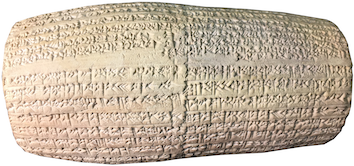New Year's temple of Uraš at Dilbat

BM 108981 a two-column clay cylinder with an Akkadian inscription of the Neo-Babylonian king Nabonidus mentioning the New Year's temple of the god Uraš. Photo credit: Frauke Weiershäuser.
An Akkadian inscription of Nabonidus (r. 555–539 BC), Babylon's last native king, records that he rebuilt the god Uraš' New Year's temple (Akkadian akītu). That text provides no details about that project, apart from stating that that Neo-Babylonian king had it built as it had been in the past. Its Sumerian ceremonial name is not know and it has not yet been identified in the archeological record.
Jamie Novotny
Jamie Novotny, 'New Year's temple of Uraš at Dilbat', Babylonian Temples and Monumental Architecture online (BTMAo), The BTMAo Project, a sub-project of MOCCI, [http://oracc.org/btmao/Dilbat/NewYear'sTemple/]